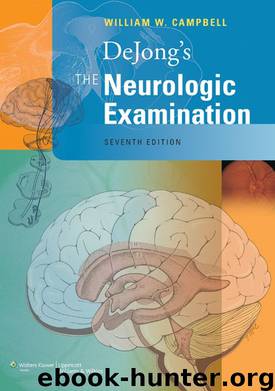DeJong's The Neurologic Examination by Campbell William W

Author:Campbell, William W.
Language: eng
Format: epub
Publisher: Lippincot (Wolters Kluwer Health)
Published: 2012-09-03T16:00:00+00:00
FIGURE 25.6 Left hemiparesis of 15 years’ duration. The patient circumducts his left leg as he begins walking.
The spasticity, or increase in tone, is most marked in the flexor and pronator muscles of the upper limb and the extensors of the lower, more apparent with an attempt to extend or supinate the muscles of the upper extremity or flex those of the lower. Passive motion may be carried out with little difficulty if done through a small range of movement, but resistance increases if an attempt is made to move the extremities through a greater range. Slow, passive movement may be carried out with relative ease, but on rapid movement, there is a “blocking” or “catching,” often with a waxing followed by a sudden waning of tone at the extremes of the range of motion (clasp-knife phenomenon). Abnormalities of muscle tone are discussed further in Chapter 28.
The paralysis that follows a vascular lesion of the internal capsule provides a common example of the effects of a CST lesion. Examination soon after the event typically reveals flaccid paralysis and areflexia on the opposite side of the body (“cerebral shock”) but is soon followed by spasticity and hyperreflexia. When the corticospinal pathways are affected by a spinal cord lesion of sudden onset, especially if bilateral, there may also be a period of flaccidity and areflexia accompanying the paralysis below the level of the lesion. This is the period of “spinal shock,” which sooner or later gives way, in most instances, to the corticospinal syndrome. During the neural shock phase, the plantar responses may be mute and the superficial reflexes absent. The pyramidal, or upper motor neuron, syndrome gradually emerges over hours to weeks with spasticity, hyperactive tendon reflexes, extensor plantar responses, and continued absence of superficial reflexes. With spinal cord lesions there is also impairment of bowel, bladder, and sexual function.
The motor deficit with CST lesions is only occasionally complete. This may be the result of the same, largely unknown, factors and mechanisms responsible for the recovery of function that follows many such lesions. Some muscles may have bilateral innervation, or there may be incomplete decussation in the medulla. The CST receives fibers from regions of the cortex other then the motor strip, and many of the motor centers in the cortex occupy a large area with overlap of the foci of localization. The primary motor cortex is only one portion of the motor system; other cortical and subcortical centers, such as the supplementary and secondary motor cortices, may assume function in the face of disease of the corticospinal system. Sensory factors influence the type and degree of paralysis and the degree of motor recovery; the prognosis for return of function is less optimistic if there is significant sensory loss. In patients with infantile hemiplegia, hemispherectomy done for seizure control may not increase the motor deficit. Removal of normally developed cortex in an adult (e.g., surgical extirpation of a neoplasm) causes a spastic hemiplegia. Yet similar removal in patients who have had
Download
This site does not store any files on its server. We only index and link to content provided by other sites. Please contact the content providers to delete copyright contents if any and email us, we'll remove relevant links or contents immediately.
| Dictionaries & Terminology | Drug Guides |
| Education & Training | Instruments & Supplies |
| Medical Atlases |
Periodization Training for Sports by Tudor Bompa(8145)
Why We Sleep: Unlocking the Power of Sleep and Dreams by Matthew Walker(6597)
Paper Towns by Green John(5065)
The Immortal Life of Henrietta Lacks by Rebecca Skloot(4502)
The Sports Rules Book by Human Kinetics(4270)
Dynamic Alignment Through Imagery by Eric Franklin(4099)
ACSM's Complete Guide to Fitness & Health by ACSM(3974)
Kaplan MCAT Organic Chemistry Review: Created for MCAT 2015 (Kaplan Test Prep) by Kaplan(3925)
Introduction to Kinesiology by Shirl J. Hoffman(3710)
Livewired by David Eagleman(3663)
The Death of the Heart by Elizabeth Bowen(3531)
The River of Consciousness by Oliver Sacks(3518)
Alchemy and Alchemists by C. J. S. Thompson(3435)
Bad Pharma by Ben Goldacre(3286)
Descartes' Error by Antonio Damasio(3209)
The Emperor of All Maladies: A Biography of Cancer by Siddhartha Mukherjee(3043)
The Gene: An Intimate History by Siddhartha Mukherjee(3029)
The Fate of Rome: Climate, Disease, and the End of an Empire (The Princeton History of the Ancient World) by Kyle Harper(2988)
Kaplan MCAT Behavioral Sciences Review: Created for MCAT 2015 (Kaplan Test Prep) by Kaplan(2921)
